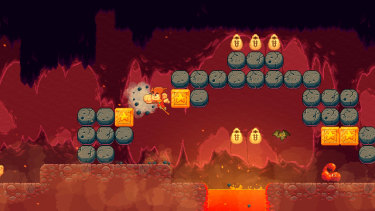
Updating a fondly remembered ’80s classic with a new look, but neglecting to do anything about its laundry list of issues, Alex Kidd in Miracle World DX is something of a missed opportunity.
From punching cash-filled blocks to accidentally releasing deadly ghosts, and from renting motorcylces to chomping down on an onigiri (or hamburger) at the end of each level, Miracle World was an innovative game that’s still talked about today. And having come built-in with many models of the popular Sega Master System in the early 1990s, it will have been one of the first video games many Australian gamers remember.

Alex Kidd in Miracle World DX certainly looks and sounds the part.
But although it’s imaginative and influential, it’s always been very flawed, and would have greatly benefited from some mechanical redesign. Unfortunately, almost all criticisms you could make of the original Miracle World also apply here in Miracle World DX.
It’s way too easy to die, and cruelly designed in some parts, for example. It can be hard to tell whether you’re in line to collide with enemies or not, which makes both of Alex’s primary actions (jumping and punching) extremely fraught. Fighting bosses via paper-rock-scissors battles — in which you die if you lose — is particularly conspicuous by how tedious and unfair it is in 2021.
You can reduce the frustration somewhat with an option to have infinite lives. But since the design of the game remains unchanged (including respawning you very close by when you die), that option also exposes the fact that the game’s tension is wholly derived from how arbitrarily mean it is.
Aesthetically it’s a different story, as the game has been fundamentally revamped. The new high-resolution pixel art is absolutely stunning, and the visual presentation is impressive and varied. One level now takes place in the rain, for example, where drops of water are blocked by objects and splash off Alex’s peticopter in unnecessary but appreciated detail.
Loading
Sonically the old tunes have been given a modern acoustic treatment and sound tremendous, while the original game’s lack of variety in this area has been addressed with a few new tracks. But as much as the game now looks and sounds like a contemporary indie experience, the fact that it still feels and plays like a mediocre 1986 one is jarring. In fact having gone back and played the original to compare, I notice they feel quite different. New Alex is floatier and a bit more cumbersome. So the developers did change the way the game plays, just not in an especially positive way.
You can switch the graphics and sound to classic mode at any time, which makes it look just like the original but in widescreen, and you even get chiptune versions of the new songs. But the fact that a lot of weirdness in how Alex moves still persists in this mode would indicate that the fundamental balance between recreation and modernisation has been fumbled here.









 Add Category
Add Category